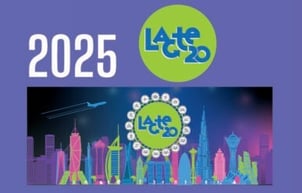Many consider Cleopatra to be the first recorded event planner in history. She knew the value of bringing people together for celebrations, announcements, and other occasions. Famously, she turned meeting Roman general Mark Antony into a fabulous event. Cleopatra entered the meeting floating down the Nile on the ancient equivalent of a luxury yacht — while dressed as the goddess Venus. Talk about making an entrance.
Cleopatra’s goal for meeting Mark Antony was clear: she wanted to form a close connection with him. The result of her event? Her dynasty got to live on for another day. From seasonal festivals to the modern New Year’s party, events have retained the same underlying goal: to build connections and bring people together for a shared experience.
While the goal of events hasn’t changed, the significant investment required to create modern business events means that there is more at stake. This is especially the case today, with a vast array of technological tools facilitating many parts of event management.
Hybrid and virtual events take this that much farther, as many (if not all) attendees experience the event through their devices. Along with being accessed via devices, online events can be joined from nearly anywhere on the globe. This presents businesses with the opportunity to reach audiences at scale. But is reaching the largest possible audience a sign of a successful event? Some businesses certainly benefit from hosting smaller events that lead to deeper connections and more meaningful networking experiences.
With so many changing factors and business models at play, let’s consider how event “success” has evolved to meet the contemporary business environment.
Which success metrics should you focus on?
What are your event goals? And how do you know when you’ve achieved them? Answering these questions will give you an idea of what success means for your business. But to determine success, you must first choose the appropriate metrics that track your progress in accomplishing your event goals.
Here are some of the most significant metrics for measuring the success of modern events:
1. Number of attendees
Measuring the number of people who attend your event is a simple way of determining success. But when counting attendance, a distinction must be made between those who signed up and those who actually attended — as Bizzado research shows, only half of registered attendees typically show up on event day.
When assessing participant numbers, consider how many attendees leave your event before it officially concludes. While it’s natural for people to log off during events, you may have an engagement problem if a significant number of attendees leave the event.
2. Revenue or tickets sold
If you’re hosting a paid event, then profitability and return on investment are extremely important.
With the right bookkeeping, this metric should be easy to determine. Simply add up all your revenue and then subtract your overhead costs. A successful event will have generated a healthy profit.
3. Social media activity and coverage
Event impact can also be measured by how many attendees talk about their experiences. As most audiences are digitally connected, tracking social media mentions supplies you with a real-time indicator of event success. The number of positive or negative mentions provides a quantitative metric, while reading attendee posts will give you qualitative data about how participants feel about your event.
For easy social media tracking, share your event handle and encourage participants to use a simple and event-specific hashtag. Apart from looking at posts, sentiment analysis and engagement metrics are important to determining how audiences engage with events.
4. Data generated
For virtual and hybrid events, the quality and quantity of data generated can be an indicator of success. If your goal is to improve your event, for example, then generating data on audience engagement is critical to achieving your goal. Or, if you’re using events to reach new prospects, then collecting prospect data is central to understanding and then converting these prospects.
But quality is extremely important here, as low-quality data will cause more harm than good. For example, poor data capture can create an incomplete picture of prospects. This can lead to bad customer experiences as you use inappropriate messaging to target these customers.
5. Lead generation
If you’re using events to create sales prospects, event success can be measured by the number of leads generated. As not all leads convert, how you qualify and attribute your leads is a crucial factor when using this metric. Counting unqualified leads, for instance, may give you a false sense of event success.
Another way of measuring success is to compare the cost per lead acquisition (CPA) for events versus your other lead generation strategies. This will give you a good sense of whether your money is better spent elsewhere.
6. Attendee happiness and satisfaction
How do you know if attendees enjoyed your event? You ask them.
Surveys are a direct tactic for gaining participant feedback about events. Depending on the information you’re looking for, surveys can be sent out before, during or after events. To improve response rates, keep surveys short and easy to answer. With the right event platform, surveys can be rolled out seamlessly for virtual and hybrid events.
For greater insights into attendee satisfaction, consider framing your questions so that you can determine your Net Promoter Score (NPS). This involves asking audiences key questions relating to how likely they are to recommend your event.
7. Inclusivity and diversity
Event success can be judged by the quality of conversation and your speaker’s subject expertise. This is why inclusivity and diversity have become markers of high-quality events. The more diverse your speaker panel, the more conversations benefit from a wealth of insights, perspectives, and experiences. When people see themselves represented, they’re also more likely to attend your event.
When looking at your last event, ask yourself: were attendees and speakers sufficiently representative of diverse voices and experiences? And were these different voices given equal time and space to deliver their message?
8. Technical success
As virtual events become more sophisticated, event planners need to work on audio and visual quality. In the journey to technical excellence, success can be measured by the number (or lack thereof) of issues and downtime. In particular, event planners must pay attention to audio and visual quality, streaming quality and how painlessly your event is accessed.
Strategies to improve audience engagement, such as gamification, often require multiple digital tools. How seamlessly these tools are integrated is another measure of event success.
Common mistakes when measuring event success
Knowing what metrics to employ is only the first step toward measuring event performance. The next step involves avoiding the common misconceptions and mistakes that event managers make when gauging event success. Here are some of them:
- Getting caught up on vanity metrics — don’t focus on metrics that make your event only appear successful. Instead, focus on accurate and meaningful measurements that provide a true indication of event success.
- Overlooking qualitative data — some event metrics are difficult to quantify. Attendee experience, accessibility, inclusivity, and streaming quality are examples of qualitative factors that shouldn’t be neglected.
- Measuring the experience of only a certain type of attendee — audience experiences may differ between demographics. If you have multilingual audiences, for instance, English-speaking participants may have different feedback than Spanish-speaking attendees. In this instance, gaining insights from both audience segments is key to understanding how your event was received holistically.
- Neglecting ‘the bigger picture’ — hyper-focusing on a limited set of metrics may lead to failure in other areas. If you host a well-attended but low-quality event, for instance, focusing on ticket sales may cause you to overlook the poor level of event experiences. Delivering poor events may lead to lower ticket sales in the future.
- Measuring the wrong thing — choosing the wrong metric can distort event success. For example, tracking engagement on a social media platform that your audience rarely uses can create the impression that attendees aren’t engaging with your event.
Refining our understanding of event success
The rise of hybrid and virtual events has changed what it means for an event to be successful. Instead of fixating solely on attendee numbers, factors like inclusivity and level of engagement have become critical to hosting high-calibre events. This change reflects a shift toward meaningful event experiences where attendees feel recognised and engaged.
Alongside creating meaningful attendance, the priorities of the hosting company range from having the right people attend events to earning a healthy return on investment. For event managers, the metrics shared above are invaluable to achieving company goals and ensuring meaningful attendance.
But there’s a difference between knowing what metrics to track and having the tools to actually measure event success. Fortunately, many digital technologies and solutions partners can help you drive success and unlock meaningful event experiences.
Find success with Interprefy
Virtual and hybrid events empower companies to reach huge multinational audiences. To craft meaningful experiences for global audiences, businesses need a way to break language barriers and present their events in each participant’s primary language. That’s where we come in.
At Interprefy, we offer a cloud-based interpreting platform for online, hybrid, and on-site events. Our remote simultaneous interpretation solution enables real-time interpretation and it integrates with any event platform, ensuring that attendees enjoy the same high-quality experience — no matter what language they speak.
Want to know if our solution can meet your event interpretations needs? Click the button below to reach out to a member of the Interprefy team.


%20(1).webp?width=1040&height=800&name=Blog%20Header%20(1600%20%C3%97%20900%20px)%20(1).webp)


 More download links
More download links



